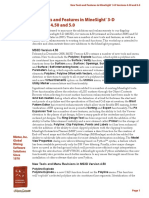Minesight Python
Uploaded by
juniorMinesight Python
Uploaded by
juniorCodigo Minesight Python
import os
import math
from Tkinter import *
from grail import gsys
from grail import messages
from grail import ag
from grail.engines import pclip
from grail.ms3d import datamanager
from grail.ms3d import selectionbuffer
from grail.ms3d import element
from grail.ms3d import elementop
from grail.data.geometry import *
from grail.data import geometry
class Radius:
def __init__(self, root):
frame = Frame(root) #root representa el parent window'
frame.pack() #Ordena la interfaz en filas y columnas'
root.title("Radios de influencia 2.0")
root.geometry("300x300")
#titulo
Label(frame,text="\nGenerar radios", font = "Arial 15 bold").grid(row=0,
column=2, columnspan=2, sticky ="WENS")
Label(frame,text="Type values\n").grid(row=1, column=2, sticky ="WENS")
#etiqueta radio
Label(frame,text="Radio ").grid(row=2, column=1, columnspan=1)
#Crea un espacio vacio
Label(frame,text="").grid(row=3, column=1, columnspan=1)
#Es la casilla de entrada para
c = Entry(frame, width=5)
c.grid(row=2,column=2, sticky=W)
c.insert(END, '200')
#define una variable tkinter usada en el spinbox
var = IntVar()
var.set("3")
#Etiqueta precision
Label(frame,text="Presicion ", font = "Arial 8").grid(row=2, column=3,
columnspan=1)
sb2 = Spinbox(frame, from_=1, to=5,width=3,textvariable=var)
sb2.grid(row=2,column=4,sticky=W)
#Define la variable tkinter string
var1 = StringVar()
#Define otro espacio en blanco
Label(frame,text="").grid(row=5, column=1, columnspan=1)
#define el texto
Label(frame,text="Dia").grid(row=4, column=1, columnspan=1)
sb3 = Spinbox(frame,width=10, values
=("Domingo","Sabado","Viernes","Jueves","Miercoles","Martes","Lunes"),
textvariable=var1)
var1.set("Lunes")
sb3.grid(row=4,column=2,sticky=W)
botondraw= Button(frame,text="Draw", command = lambda :self.draw(sb2,sb3,c)
, font = "Arial 12 bold").grid(row=7,column=1,columnspan=2,ipadx=25)
botonint= Button(frame,text="Intersect", command = lambda
:self.intersect(), font = "Arial 12
bold").grid(row=8,column=1,columnspan=2,ipadx=12)
botonexit = Button(frame,text="Cerrar",fg="red",command= root.destroy ,
font = "Arial 12 bold").grid(row=7,column=3,columnspan=2,ipadx=20, padx=1)
root.mainloop()
You might also like
- Proyecto Hilarión, Yacimiento Tipo Skarn de Zn-Pb-Ag - (Cu), Exploración Con Sondajes DirigidosNo ratings yetProyecto Hilarión, Yacimiento Tipo Skarn de Zn-Pb-Ag - (Cu), Exploración Con Sondajes Dirigidos25 pages
- Implementation of Ultimate Pit Limit Algorithms With Microsoft ExcelNo ratings yetImplementation of Ultimate Pit Limit Algorithms With Microsoft Excel6 pages
- MineSight Grail-Data Access and Embedded ScriptsNo ratings yetMineSight Grail-Data Access and Embedded Scripts11 pages
- Sequencing Mining Operations With MineSightNo ratings yetSequencing Mining Operations With MineSight55 pages
- Starting Up MineSight For Your Coal Mine ProjectNo ratings yetStarting Up MineSight For Your Coal Mine Project23 pages
- Application of Economic Parameters and Cutoffs During and After Pit OptimizationNo ratings yetApplication of Economic Parameters and Cutoffs During and After Pit Optimization8 pages
- Extending Multi-Runs With Python® and Standalone Engines: Mining SoftwareNo ratings yetExtending Multi-Runs With Python® and Standalone Engines: Mining Software7 pages
- Kriging Efficiency - A Practical Analysis The Effect Spatial Structure and Data - KrigeNo ratings yetKriging Efficiency - A Practical Analysis The Effect Spatial Structure and Data - Krige12 pages
- New Tools and Features in MineSight 3-DNo ratings yetNew Tools and Features in MineSight 3-D16 pages
- New Tools and Features in Minesight 3-D Versions 4.50 and 5.0No ratings yetNew Tools and Features in Minesight 3-D Versions 4.50 and 5.027 pages
- Maptek Australia2012 Sean Dixon Using ROM in HARP Modelling100% (2)Maptek Australia2012 Sean Dixon Using ROM in HARP Modelling23 pages
- Datamine Studio UG: The Complete Solution For Underground Design and SchedulingNo ratings yetDatamine Studio UG: The Complete Solution For Underground Design and Scheduling3 pages
- Revisión de La Biblioteca de Rutinas: 27TH Annual Mintec SeminarNo ratings yetRevisión de La Biblioteca de Rutinas: 27TH Annual Mintec Seminar5 pages
- JORC Code 2012 Spanish Translation March 2018100% (1)JORC Code 2012 Spanish Translation March 201860 pages
- Geostatistics Approach To Simulating Zinc Grades: Case StudyNo ratings yetGeostatistics Approach To Simulating Zinc Grades: Case Study2 pages
- Studio RM: The World'S Leading Resource & Reserve SolutionNo ratings yetStudio RM: The World'S Leading Resource & Reserve Solution2 pages
- 01 Autoslicer Application and Intergration MSAP OP Short-Term Planning RENo ratings yet01 Autoslicer Application and Intergration MSAP OP Short-Term Planning RE26 pages
- Minesight Schedule Optimizer - A New Tool: Global Mining Software Solutions Since 1970No ratings yetMinesight Schedule Optimizer - A New Tool: Global Mining Software Solutions Since 197028 pages
- Navarra2018 Modelos Geometalurgicos para El PlaneamientoNo ratings yetNavarra2018 Modelos Geometalurgicos para El Planeamiento9 pages
- MineSight Reserve-The Power of Specialized Reserves Tool100% (1)MineSight Reserve-The Power of Specialized Reserves Tool21 pages
- New For MineSight Economic Planner Presentation by Jose SanchezNo ratings yetNew For MineSight Economic Planner Presentation by Jose Sanchez42 pages
- 3-1 Takt Time and Line Balancing-Takt SignNo ratings yet3-1 Takt Time and Line Balancing-Takt Sign7 pages































































